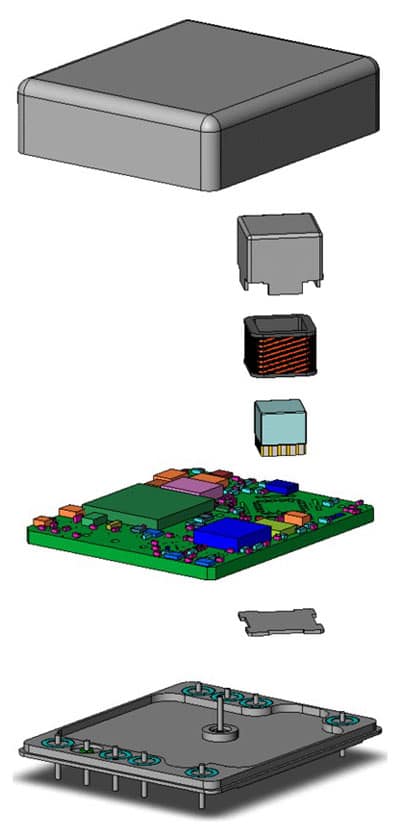
Researchers in the US have developed the world’s smallest commercial atomic clock. Known as the SA.45s Chip Size Atomic Clock (CSAC), it could be yours for just $1500. The clock, initially developed for military use, is about the size of a matchbox, weighs about 35 grams and has a power requirement of only 115 mW. Not your everyday timekeeper, the team behind the clock claim that it could have varied and wide-ranging applications, from disabling bombs to searching for oil.
Atomic clocks use a specific electronic transition frequency of an atom as a frequency standard, with the “ticks” being the oscillations between two energy states in an atom. Generally, a feedback loop is used to lock the frequency of a light source to that of the transition, thus creating a stable frequency standard.
This latest clock has been jointly developed at Symmetricom, Draper Laboratory and Sandia National Laboratories in the US. The clock comprises a highly compact “physics package” that contains the caesium atoms used and sits on a circuit board within a tiny box. The caesium atoms are held within a resonance cell and are heated to a vapour state by plates situated at the top and bottom of the package.
Modulating microwaves
An optimized vertical-cavity surface-emitting laser (VCSEL) is shone through the vapour, causing excitation in the caesium atoms. The laser light is modulated by a microwave signal generator on the chip. This allows the laser’s single beam to excite the caesium atoms at two different energy levels. Interference between these two levels is then detected by a photodiode that forms part of a feedback loop. The loop optimizes the number of photons absorbed by the caesium atoms. The clock indicates that 1 s has elapsed after counting exactly 4596,315,885 cycles of the microwave oscillator signal.
The physics package is vacuum sealed and then covered by a layer of magnetic shielding, before being placed on the printed circuit board (PCB), which is then sealed so that it is airtight. The lid and base plate of the array both serve as a second layer of magnetic shielding.
All the components on the PCB are optimized for power efficiency at the smallest size possible. As a result, the circuitry around the physics package consumes about 95 mW, with the physics package itself consuming about 10 mW. Allowing for production faults, the CSAC has a total power consumption of only 115 mW, according to Steve Fossi, Symmetricom’s director of business development.
Idea born at NIST
In 2004 Physics World reported that John Kitching and his team at the US National Institute of Standards and Technology (NIST) in Boulder, Colorado, created what was then the most compact and portable chip-scale atomic clock. So what is different about this latest device? According to Kitching, this new product is essentially a commercial version of the work pioneered by his group at NIST between 2001 and 2005. “The Symmetricom collaboration also had an active research programme during that time that was funded in parallel with ours by the Defense Advanced Research Project Agency [DARPA].”
While the Symmetricom and NIST clocks are about the same size, the main advantage of this new clock is that the power required to run it is much less than any previous commercial atomic clock: 115 mW, compared with more than 1 W for all other atomic clocks. “This means it will open many new applications for precision timing, particularly those where only battery power is available,” says Kitching.
“Because few DARPA technologies make it to full industrial commercialization for dual-use applications, this is a very big deal,” says Gil Herrera, director of Sandia’s Microsystems and Engineering Sciences Application centre. “CSAC now is a product with a datasheet and a price.”
“The work between the three organizations was never ‘thrown over the wall’,” says Sandia manager Charles Sullivan, using an expression that has come to mean complete separation of effort. “There was tight integration from beginning to end of the project.”
Jamming roadside bombs
The clock could find a use in disabling improvised explosive devices (IED) or roadside bombs that are detonated wirelessly using everything from mobile phones to toy remote controls. Such bombs can be disabled using portable jammers that block all communications signals in the area. While this solves the immediate problem of the bomb, it also prevents friendly forces from using radio communications. The CSAC would provide the precise timing required to jam bomb-related communications while allowing friendly signals to get through.
The device could also be used in places where GPS timing signals are not available, for example in deep-sea diving, mining and seismic research. In particular, the clocks could be deployed in underwater sensors that rely on the precision timing of seismic signals for oil and gas exploration. In this case, the clocks on each sensor would need to be accurate, small and run on very low power so that the sensors could remain underwater for prolonged periods of time. The CSAC has only 10–20% of the power requirement of existing sensor clocks but is about a 100 times more accurate.




